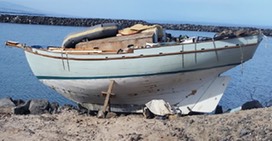Another Recipe for Disaster
Although the captain could have removed the Kolina from the water or sought other commercial alternatives to get the vessel to Molokai, he chose an unsafe option, likely due to financial constraints.
Of course, this is yet another example of the fact that most accidents consist of a chain of events that lead up to the final outcome.

Herreshoff designed the original H28 in 1943 as an auxiliary cruising ketch "for the man who has only a limited time to sail, and who must report to the office without fail on Monday morning.” He recognized the need for a boat that could be rigged quickly for a summer evening sail, that could coast along in light breezes, as well as stand up to anything. He also realized that many of his customers would want to cruise in relatively shallow waters, and anchor in quiet, picturesque bays without having to row a mile to the shore.
The waterline length (LWL) of the H-28 genre is about 23.5', which would give the vessel a theoretical hull speed of about 6.5 knots.
What happens when you go to sea in an unseaworthy vessel, configure the center of effort aft of the center of lateral resistance on your 28' displacement-hull 'shoal draft' cruiser that has no workable steering — and then exceed the hull speed?
The National Transportation Safety Board determines that the probable cause of the accident involving Coast Guard cutter Kiska and recreational vessel Kolina, with the death of the Kolina captain, was the Kolina captain’s decision to launch and operate a poorly maintained vessel and his failure to protect his personal safety during the subsequent tow in the Alenuihaha Channel.
You can read the NTSB PDF report here.
/fl
